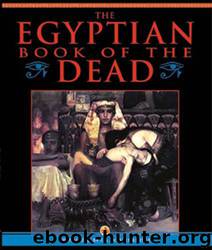The Egyptian Book Of The Dead by E.A. Wallis Budge

Author:E.A. Wallis Budge [Budge, E.A. Wallis]
Language: eng
Format: epub
Published: 2011-08-18T00:56:45+00:00
[1. Naville, Einleitung, pp. 48-54.
2. See Brugsch, Aegyptologie, p. 223.
3. In the list of the high officers of the priesthood given by Brugsch ( Aegyptologie, p. 218), we meet with an official whose title is ###, "the scribe set over the sacred property of the gods"; Ani held a similar appointment.
4 Plate 19; her name is nowhere else mentioned in the papyrus.]
{p. cxlv}
means has not yet been decided, but qemat is the title applied to the noble ladies who sang or played on an instrument in the temple of a god.[1] The lady Thuthu belonged to the number of the priestesses of the god Amen-Ra at Thebes, and she always carries in her hands the sistrum. and the instrument menat, the emblems of her office. Thus Ani and his wife were high ecclesiastical dignitaries connected with the famous confraternity of the priests of Amen.
Copies of the Book of the Dead in the Theban period.
Age of the papyrus.
An examination of the papyri of the Theban period preserved in the British Museum shows that two distinct classes of Book of the Dead papyri existed in the XVIIIth dynasty. In the first both text and vignettes are traced in black outline,[2] the rubrics, catchwords, etc. , alone being in red colour; in the second the text only is black, the rubrics, etc. , being red, and the vignettes beautifully painted in a number of bright colours. To the latter class the papyrus of Ani belongs, but, if the text and vignettes be compared with those found in any other early Theban papyri, it will be seen that it occupies an independent position in all respects. Though agreeing in the main with the papyri of the XVIIIth dynasty in respect of textual readings, the papyrus of Ani has peculiarities in spelling, etc. , which are not found in any of them. The handwriting of the first section at least suggests the best period of the XVIIIth dynasty; but as the scribe forms some of the characters in a way peculiarly his own, the palæographic evidence on this point is not decisive. That the papyrus belongs to the period which produced such documents as the papyrus of Neb-qet,[3] and the papyrus of Qenna,[4] i.e. , to some period of the XVIIIth dynasty, is tolerably certain; and we may assume that it is older than the papyrus of Hunefer, which was written during the reign of Seti I.; for, though belonging to the same class of highly decorated papyri, the execution of the vignettes is finer and more careful, and the free, bold forms of the hieroglyphics in the better written sections more closely resemble those of the texts inscribed in stone under the greatest kings of the XVIIIth dynasty. The "lord of the two lands," i.e. , of Upper and Lower Egypt, or the North and South, mentioned in pl. 4, is probably one of the Thothmes or Amenhetep kings, and accordingly we may place the period of our papyrus between 1500 and 1400 years B.
Download
This site does not store any files on its server. We only index and link to content provided by other sites. Please contact the content providers to delete copyright contents if any and email us, we'll remove relevant links or contents immediately.
The Four Agreements by Don Miguel Ruiz(6324)
Breaking Free by Rachel Jeffs(4013)
The Hatha Yoga Pradipika (Translated) by Svatmarama(3078)
120 Days of Sodom by Marquis de Sade(2943)
Member of the Family by Dianne Lake(2264)
The Tao of Physics by Fritjof Capra(2168)
The Psychedelic Gospels: The Secret History of Hallucinogens in Christianity by Jerry B. Brown(2073)
The Road to Jonestown by Jeff Guinn(1983)
Going Clear: Scientology, Hollywood, and the Prison of Belief by Lawrence Wright(1884)
Going Clear by Lawrence Wright(1873)
Uriel's Machine by Christopher Knight(1825)
The Grand Grimoire: The Red Dragon by Author Unknown(1712)
The Gnostic Gospel of St. Thomas by Tau Malachi(1681)
Key to the Sacred Pattern: The Untold Story of Rennes-le-Chateau by Henry Lincoln(1556)
The Malloreon: Book 02 - King of the Murgos by David Eddings(1518)
Waco by David Thibodeau & Leon Whiteson & Aviva Layton(1489)
The New World Order Book by Nick Redfern(1486)
The Secret of the Temple by John Michael Greer(1423)
The Initiatory Path in Fairy Tales by Bernard Roger(1397)
